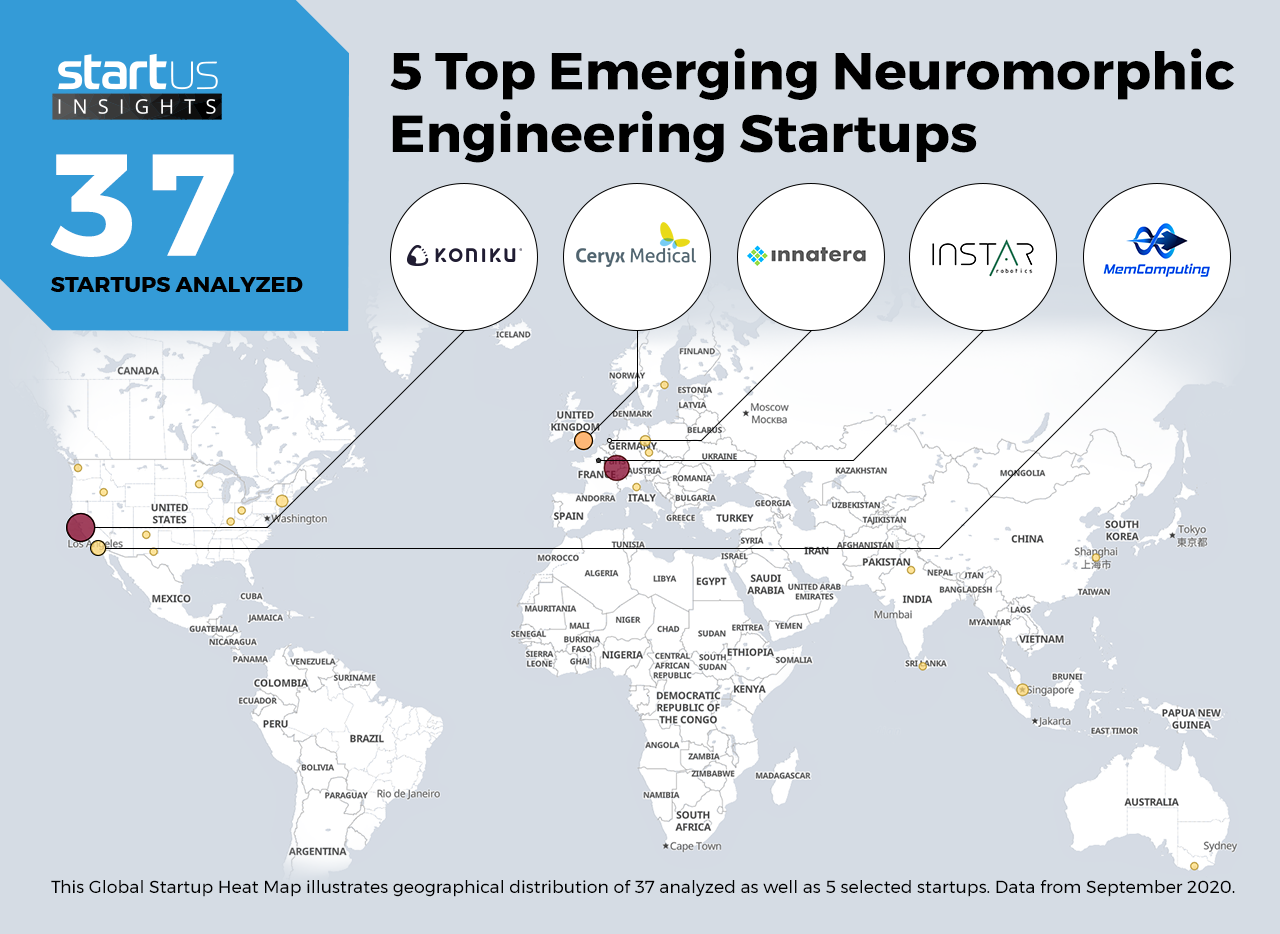Our Innovation Analysts recently looked into emerging technologies and up-and-coming startups working on advanced computing solutions. As there is a large number of startups working on a wide variety of solutions, we decided to share our insights with you. This time, we are taking a look at 5 promising neuromorphic engineering startups.
Heat Map: 5 Top Neuromorphic Engineering Startups
Using our StartUs Insights Discovery Platform, covering 1.379.000+ startups & scaleups globally, we looked at innovation in the field of advanced computing. For this research, we identified 37 relevant solutions and picked 5 to showcase below. These companies were chosen based on a data-driven startup scouting approach, taking into account factors such as location, founding year, and relevance of technology, among others. Depending on your specific criteria, the top picks might look entirely different.
The Global Startup Heat Map below highlights 5 startups & scaleups developing innovative solutions for neuromorphic engineering. Moreover, the Heat Map reveals regions that observe a high startup activity and illustrates the geographic distribution of all 37 companies we analyzed for this specific topic.
Innatera – Neuromorphic Processors
Neuromorphic engineering emulates the architecture of the brain, or other components of the nervous system, to deliver fast and efficient computation. This enables the next generation of artificial intelligence (AI), driven by cognition rather than by logic or perception. Startups are working on neuromorphic microprocessors that improve computing speeds to enable new computation-intensive applications.
Innatera is a Dutch startup that uses neuromorphic engineering to develop advanced microprocessors. The startup’s neuromorphic processors mimic the brain to achieve ultra-efficiency. Innatera employs a spiking neural network (SNN) architecture to deliver high cognition with a narrow power envelope. The solution further enables low-power, low-latency, and high-performance always-on processing.
MemComputing – Memristive Computing
Neuromorphic architecture generally comprises hybrid analog and digital circuits. However, there is an upper threshold to data transfer rates when logic and memory are on different units. Memristive computing overcomes this barrier by enabling computation directly in memory. The technology enables startups to employ neuromorphic engineering for next-generation, intelligent computing.
The US-based startup MemComputing develops solutions for industrial computations. The startup’s platform, Virtual MemComputing Machine, uses brain-inspired algorithms to solve optimization problems. It delivers performance that sometimes exceeds classical or quantum computing solutions available today. The software-as-a-service (SaaS) platform further enables companies to improve operational efficiencies and increase profitability.
INSTAR Robotics – Neuro-Inspired Robotics
Cognitive robots use advanced algorithms to learn complex skills and find applications in many industries, including healthcare, education, and manufacturing. In neuro-inspired robotics, sensors feed neuronal architectures that help autonomous robots navigate, as well as perform specialized tasks. Startups are working on solutions that introduce neuromorphic sensory systems in robots to improve their energy efficiency, speed, and robustness.
INSTAR Robotics is a French startup that provides neuro-inspired robots for agriculture. The robots use neural network algorithms to interact with their surroundings and make decisions. Further, the robots do not require any training or instruction upon installation. The startup’s robots work alongside workers in agricultural logistics and plant nurseries.
Ceryx Medical – Medical Devices
Machine learning and wearables are transforming how medical devices collect and analyze data. Neuromorphic sensors are comparable with their biological counterparts and also provide the ability to control involuntary and voluntary rhythmic processes. Startups are working on solutions that combine deep learning and neuromorphic hardware to provide better performing medical devices.
British startup Ceryx Medical develops bioelectronic devices. The startup’s devices use a proprietary microchip technology. The solution uses neuromorphic engineering and central pattern generators (CPGs) to mimic the body’s nerve centers. This enables the development of new clinical tools that improve treatment efficacy and patient outcomes.
Koniku – Neuromorphic Chips
Neuromorphic chips mimic individual neurons and synapses, as well as the emergent computational power and efficiency of the brain. While these are inspired by biology, startups are also working on solutions that supplement these with biological neurons. These solutions enable highly sensitive and computationally-efficient sensing applications.
Koniku is a US-based startup that offers nanotechnology devices for brain-machine interfaces and other applications. The startup programs deoxyribonucleic acid (DNA) to confer control, sense, and computation abilities of neurons. The solution combines DNA programming and neuromorphic engineering to build computer chips with biological neurons. Koniku’s solutions find applications in security, defense, and agriculture.
What About The Other 32 Solutions?
While we believe data is key to creating insights it can be easy to be overwhelmed by it. Our ambition is to create a comprehensive overview and provide actionable innovation intelligence and enable you to achieve your goals faster. The 5 neuromorphic engineering startups showcased above are promising examples out of 37 we analyzed for this article. To identify the most relevant solutions based on your specific criteria, get in touch.



![AI in Automotive: A Strategic Guide for Industry Leaders [2025-2030]](https://www.startus-insights.com/wp-content/uploads/2025/03/AI-in-Automotive-SharedImg-StartUs-Insights-noresize-420x236.webp)






